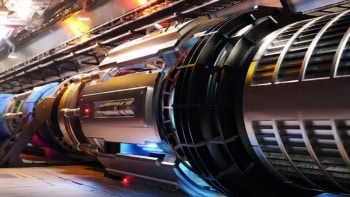
Calculations by physicists in China and the US suggest that the charmonium meson has a distinct onion-like structure. The team used a simplified version of quantum chromodynamics (QCD) and extensive computer simulations show that the subatomic particle comprises nested layers, each containing different types of constituent particles.
“Charmonium is made [primarily] of a pair of charm quark and antiquark, and is one of the simplest hadrons,” explains Xingbo Zhao of the Institute of Modern Physics and University of Chinese Academy of Sciences, who is one of the team members. “Its constituent quarks are very massive compared to the [up and down] quarks that make up the proton and the neutron,” explains Zhao.
“It is sometimes dubbed as the hydrogen atom within quantum chromodynamics,” he adds. This is because, like the hydrogen atom, it is a fundamental, relatively simple system that provides deep insights into the underlying forces and interactions that define its properties.
Strong interaction
The strong interaction bind quarks into composite objects called hadrons (which include mesons like charmonium) through the exchange of gluons. This is similar to how electromagnetic interactions between charged particles are mediated by photons, the quanta of the electromagnetic field.
However, QCD – the theory of strong interactions – is significantly more complex than quantum electrodynamics – which is the theory describing the electromagnetic interaction. This complexity makes accurate calculations of the properties of hadrons extremely challenging. Complexity has also led researchers to use simplified versions of QCD, whose validity must be confirmed by comparing their predictions with experimental data.
In their recent study, Zhao and colleagues examined charmonium using a simplified theory, where the number of constituent particle states is artificially limited and not all the intricate aspects of quark interactions are considered.
This approach, known as basis light-front quantization, allowed the team to numerically compute the distribution of mass and pressure inside charmonium. In the mathematical machinery of QCD, these distributions are encoded in gravitational form factors.
Energy and force distributions
“Gravitational form factors describe how a hadron, such as the proton, interacts with a graviton, the quantum of gravity,” said Zhao. “They are interesting because they encode the energy and force distributions inside the hadron.”
The knowledge of these form factors allowed the researchers to deduce the structure of charmonium, showing where the stable charm and anti-charm quarks (known as valence quarks) are located, as well as the regions occupied by the virtual quarks constantly born and disappearing into the vacuum (called wee partons). Moreover, the study reveals that the structure of charmonium also includes entire virtual hadrons, such as pions, kaons and eta mesons, as well as glueballs consisting only of gluons.
“We found that charmonium is a layered system like an onion!” explained Zhao. “At the core are the valence quarks. Then, the valence core is surrounded by the so-called wee partons. The outermost layers of charmonium are glueballs and meson clouds. This layered structure is consistent with the picture established in high-energy collision experiments.”
Confirmation and implications
These findings represent a significant advancement in our understanding of strong interactions, confirming that approximate methods of QCD can accurately describe experimental data.
The researchers believe that the mass and pressure distributions inside charmonium that they derived can be measured with high precision in future high-energy collision experiments, such as those planned at the upcoming Electron-Ion Collider in the US. This would further validate the basis light-front quantization method.
The research is described in a paper in Physical Review D.
“I find this paper very interesting for two reasons,” explains Volker Burkert, of the Thomas Jefferson National Accelerator Facility in Virginia, who was not involved in this study. “First, it studied a particular type of hadrons, with one charm quark and one anti-charm quark, which are much heavier compared to quarks in a proton. Second, I find it of particular interest that the pressure structure of this particle is predicted to have several zero crossings. This may indicate that there are nearly disconnected pressure regions. It would be extremely interesting if this could be experimentally verified.”
Prospects and challenges
Zhao and colleagues hope to further refine their approach to study the structure of charmonium in even greater detail. For example, their method currently does not allow to differentiate the contributions of glueballs and mesons to the outermost shell of charmonium.
Additionally, the constant improvement of computer technology, crucial for such calculations, is expected to enhance the accuracy of their analyses and enable the application of their method to study other hadrons.
“In the future, we aim to extend our method to study the proton, neutron, and even nuclei,” concluded Zhao. “For complex systems like the proton, gluons play a crucial role. We need a better treatment of these interactions and, more importantly, a sophisticated computational scheme to handle the large scale of calculations required. Basis light-front quantization is designed to achieve this on near-term supercomputers or, ideally, on future quantum computers.”



